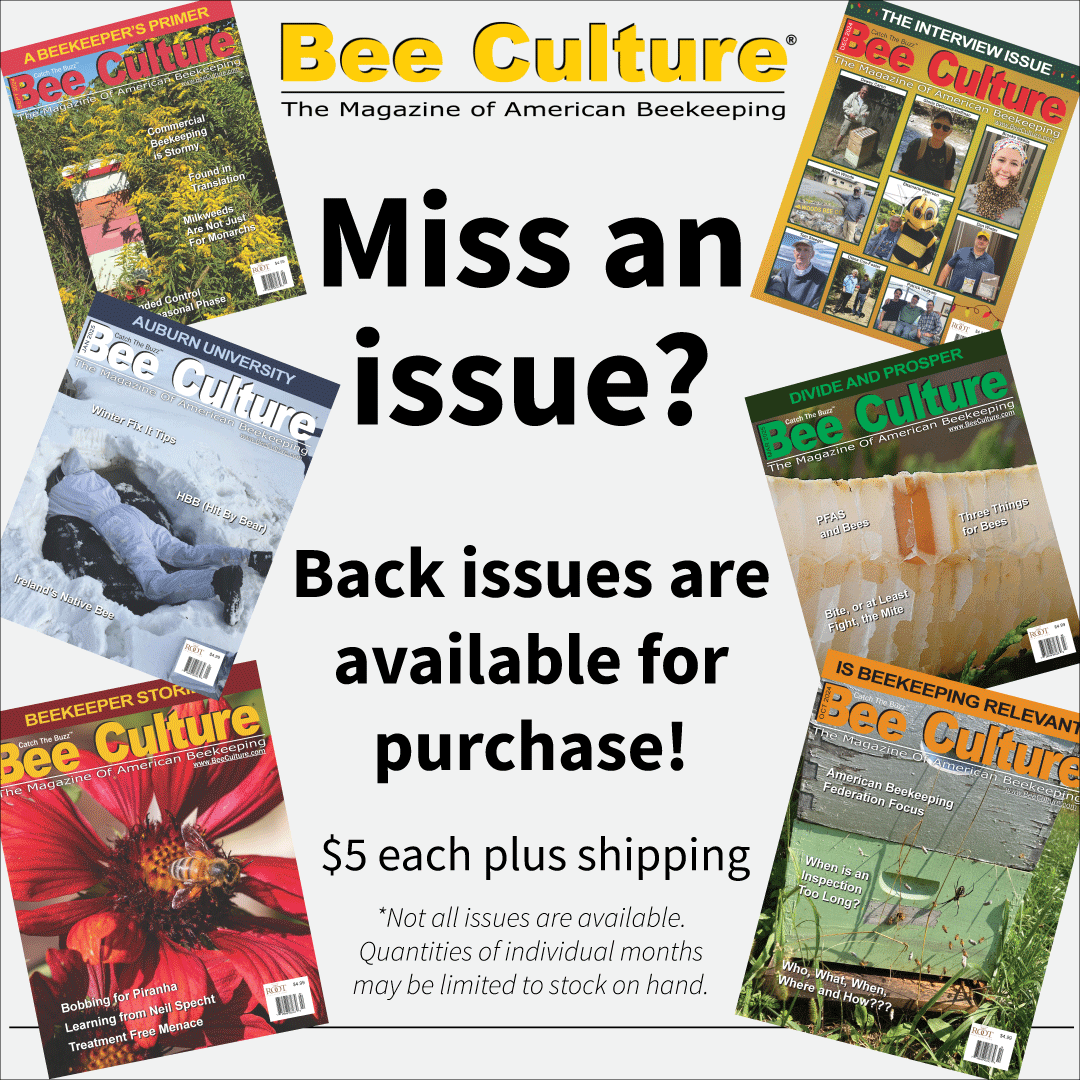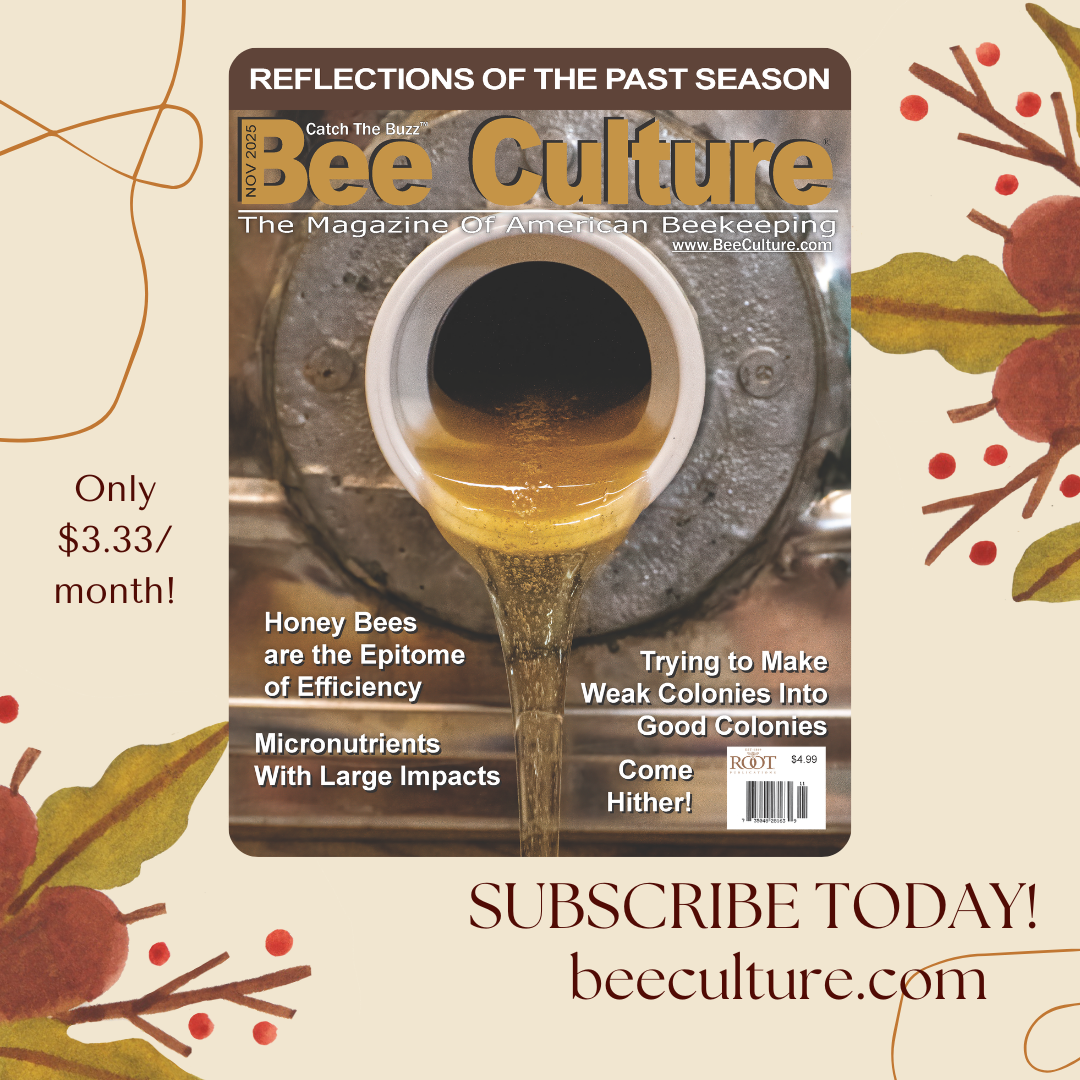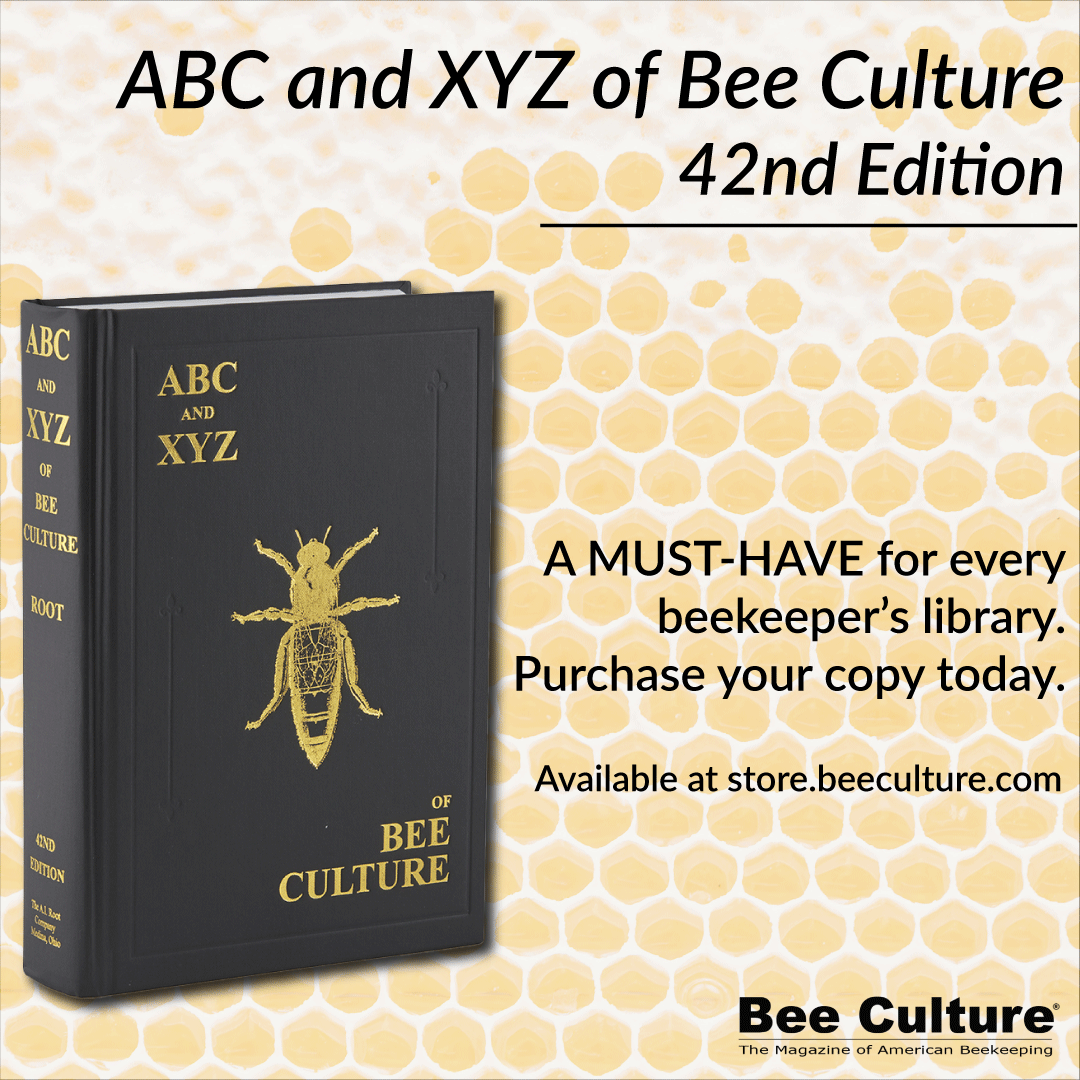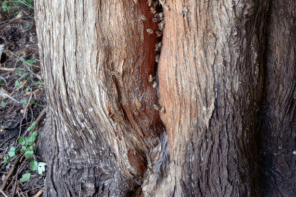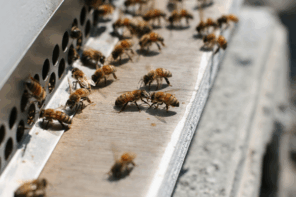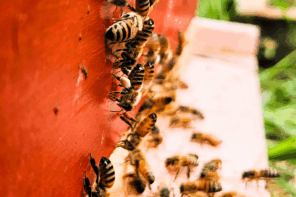By: Wyatt Magnum
This article originally appeared in the Winter 2018 issue of BEEKeeping Your First Three Years
Top Bar hives need a hanger for a protein patty! And Small Hive Beetles just love them, too!
Feeding a pollen substitute helps stimulate brood production during different seasonal conditions.
In my location, Piedmont Virginia (mid-Atlantic), the Fall nectar and pollen flow is marginal (from golden rod and aster). Summer rains help to enhance the pollen coming in by early Fall. Conversely, a dry Summer can easily cause a pollen shortage. Rampant seasonal mowing also destroys these resources (see Figure 1). In late Summer and early Fall, the need for pollen is critical. During this time, colonies produce their long-lived over-wintering bees needed to sustain the colony until the following Spring.
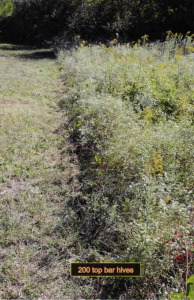
Figure 1 Death on the left meets life on the right. On the left, excessive mowing has destroyed the wildflower diversity, leaving a green desert of grass. On the right, aster, the tiny snow-white flowers, and goldenrod provide nectar and pollen to honey bees, and other insect communities living on nectar: solitary bees, bumble bees, butterflies and moths, even wasps and flies.
An alarming scenario would be dry Summer conditions, leading to a severe pollen shortage by the Fall. That would damage the production of long-lived bees, increasing colony mortality in the Winter.
Part of vigilant bee management is planning for pollen shortages. Then in the beginning of their occurrence, the beekeeper can respond rapidly, delivering pollen substitute to the hives, across all apiaries, with an efficient method to maintain colony health.
Frame-hive beekeepers do that. From bee supply companies, they purchase a pollen substitute, prepared as a patty roughly ½ inch thick, sandwiched between two thin papers. A one-pound patty fits snugly between the top and bottom bars of frames in the vertically stacked hive bodies.
Top-bar hive beekeepers need a feeding method too, using the same commercially prepared patties (see Figure 2). However, the top-bar hive requires a hanger to hold the patty, all of which is more complicated compared to just laying the patty on the top bars of a frame hive. In 2015, I began designing patty feeding methods with various wire hangers during dearth conditions.
For the resulting patty feeding design, I paid close attention to the difficulties presented by small hive beetles in the heat of Summer when their invasion pressure is high. I wanted these conditions to be similar to those in the Southeast, as close to the worst case as possible, producing a severe test of my patty feeding design.
In case beekeepers want to change my design, keep these two points in mind:
1) The bees should have continuous access to the maximum surface area of the patty. Therefore, do not put the patty on the floor of the top-bar hive with either a screen or wooden floor. Adult small hive beetles can get up under the patty and produce larvae, which tunnel inside the patty, where the bees cannot evict them (see Figure 3).
2) Be careful about feeding a colony too much patty at one time. think about the last part of the patty to be eaten by the bees. How long will that take given the local conditions? If feeding too much patty, the last part could remain for too long in the hive. Consequently, small hive beetle larvae would have more time to foul it. Then the bees will reject the remaining patty, leaving the rest for the beetle reproduction (see Figure 4). From my observations, I came to see pollen substitute as a cryptic source of new beetles if not properly applied.
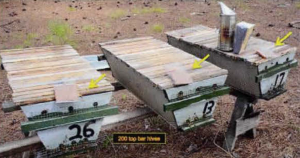
Figure 2 Ready to insert pollen patties into three top-bar hives. I have removed the hive covers and dealt out the patties {pointed out by the yellow arrows). The patties will hang between the combs from homemade wire hangers. I usually feed pollen patties to about 25 top-bar hives at a time. These “pollen patties” are actually a pollen substitute and do not contain natural pollen. Nevertheless, the slang is to call them pollen patties. These top-bar colonies were finishing a pollination contract, pollinating squash.
A starting amount of patty that has worked under my Summer time dearth conditions with severe pressure from small hive beetles has been a 1/3 to 2/3 pound. That patty amount is for colonies covering their top-bar combs from the entrance end of the hive extending back for two to three feet long. (I have topbar hives up to five-feet long, but the colony is smaller than that in the Summer.) As expected, most strong top-bar colonies can consume one-third of a pound of pollen patty quickly, easily in less than a week, especially in a pollen dearth. Surprisingly a few will not. Usually I do not feed a pound of patty at once. Rather, I feed two-thirds of a pound. Then I reevaluate after the first feeding to see how quickly the bees consumed the patties. On the other hand, if the bees are foraging on some minor Summer source, I will start even strong colonies with 1/3 pound and see how quickly they consume the patties. (I am expecting the consumption to be slower, and overfeeding could provide some of the patty to small hive beetles.)
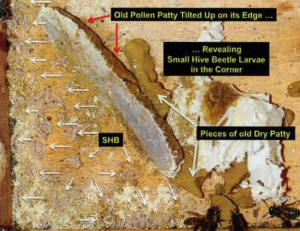
Figure 3 Small hive beetle larvae hidden under a pollen patty on the floor of a hive. Even propping up in a comer, letting the bees get to both sides, did not work. The patty does not have that much structural strength, and it eventually fell over. Then the patty provided a protected refuge for adult small hive beetles, and they began producing larvae. Conditions were “dry” in this situation and there was no slime.
For smaller colonies, like a nuc, a colony in a one-foot long top-bar hive, or even mating nucs, a pair of colonies in a one-foot long hive separated by a partition, I give them smaller pieces of a patty (much less than 1/3 pound). For the exact patty size, I just estimate it from the cluster size, being careful not to give a small colony too much. The small patties still go into the hangers. With these smaller colonies, I need to make sure the patties stay protected within the clusters for the feeding cate some of the duration. Otherwise small hive beetles will likely infest them.
Before diving into the details of a full-size hanger (holding one-third of a pound patty), Figure 5 shows a miniature version of the hanger design in a single-comb top-bar observation hive with a small piece of patty. The patty resides in the fold of the hardware cloth. The wire grid doubles over, supporting both sides of the patty, ideally with no hiding places for pests. Several rounds of testing in my apiaries showed patties (1/3 pound) needed support on both sides by the wire grids. Otherwise, the patty slouched, or flopped over forming folds, which became refuges for small hive beetle larvae to begin an infestation.
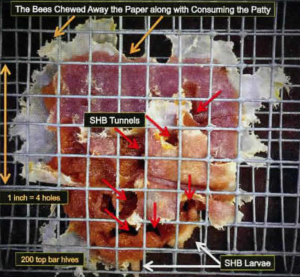
Figure 4 A small piece of patty infested
by small hive beetle larvae. Only about1 ½ square inches remained when the
other colony had finished their patties from Summer feeding during intense small hive beetle activity. The two white arrows point to beetle larvae, difficult to discern without
magnification. Notice the numerous tunnels in the pollen substitute. Red arrows indicate some of the tunnels.
Notice in the observation hive, the hanger, as a single grid of wire extends up (by the honey band) and protrudes out of the hive as a bent-over tab, holding the patty in place and marking the hanger’s location for its quick recovery. As explained below, I want the patty at the edge of the brood nest. Figure 6 shows that same edge location as a thermal (heat) image.
Here are the directions to construct a full-size hanger (holding 1/3 pound). I use a ¼ inch wire hardware cloth, a common mesh size easily found at hardware stores. The cross section of my top-bar hive dictated the hanger’s dimensions. The hanger size should work for similar size top-bar hives; just make a trial hanger and see.
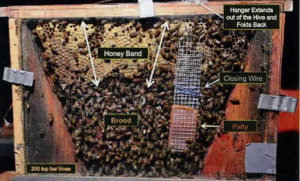
Figure 5 A top-bar observation hive testing a patty feeding method. The miniature wire
the hanger patty works position like a is full-size one. Ideally the patty position is below the honey bands, where there is a little more space
between the brood combs. The hive is in a special bee house with 30 single-comb top-bar observation hives, where I study bees and film their behavior.
The hanger dimensions aim to lower the patty below a typical (capped) honey band because lower down there is a little more distance between the combs. Between the upper-capped honey bands which can bulge, the bees leave a minimum of one bee space. Lower down, between the brood part of the combs, which do not bulge, the bees leave two bee spaces, for nurse bees working back-to-back. I could have made the hanger to hold the patty even lower because in some situations the patty may still be between extra wide honey bands. Two points against that are: 1) a larger hanger is bulky to handle to pack and transport; 2) As the patty approached the lower edge of the comb, it has less protection by bees against small hive beetles.
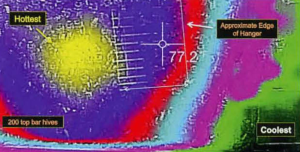
Figure 6 A close-up thermal image of the observation hive from Figure 5. The pollen patty is at the same location in the color-coded scene (yellow is the hottest and green the coolest). The patty is in the blue, a location of intermediate warmth, near the edge of the brood nest. The patty has plenty of warmth around it from the bee activity, a situation ideal for quick consumption. The 77.2 degrees F is the camera-reported temperature on the outside of the glass, cooler, of course, than inside the hive.
Using Figure 7 as a guide, the dimensions of the wire rectangle are 15¾” by 4″ (63 by 16 mesh holes). If your wire cutting is off a little bit don’t fret. It need not be exact. Now make the bottom fold that cradles the patty. With the rectangle lying on its side like in Figure 7, measure 6 inches (24 mesh holes) from the (lower) bottom and fold it around to the right as shown. When bending the wire grid, it is best to put a little flat stick in the fold so the crease will be wide, helping it to accept the width of the patty as indicated in Figure 8.
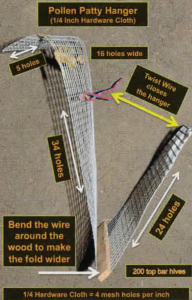
Figure 7 Bending the wire grid to make the pollen patty hanger. The directions are in the text. The 24-hole side will support the patty vertically against the other side. A vertical patty in the hive environment needs wire on both sides, from top to bottom, for complete support. Otherwise, the patty will slump over and give refuge to small hive beetles. Note the thin red and blue wire. It lines up with the top edge of the wire that will hold the patty, closing the hanger.
Next make the top tab, which sticks out of the hive. Measure 1 and ¼ inches (five holes) from the top of the rectangle. Make a right angle fold by bending that part of the wire to the left as shown in Figure 7. This folded part forms a tab protruding through the top bars, which is bent over and keeps the hanger from slipping down in the hive. The tab also reminds the beekeeper which hives still have hangers in them.
Now make a closure from a scrap of thin wire, which holds the wire grids around the patty. Twist on a short piece, about three inches long of wire to the long side of the hanger, even with the top of the other wire grid as shown in Figure 7. Figure 8 shows the twist of wire closing a new hanger as it is loaded with a pollen patty.
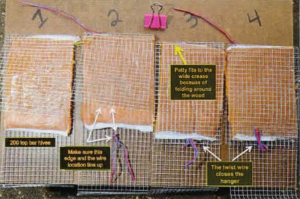
Figure 8 Loading a new hanger with a patty in four positions. See the thin red and blue wire about three inches long (position]) to close the hanger. Locate that closing wire where it will close the end of the folded wire grid as shown in position 2. Fold over the closing wire on the long side of the hanger grid. With a patty loaded in the hanger, press the two wire grids together gently. Hook the closing wire tails through to the opposite grid as shown in position 3. Thread the closing wire tails back through to the other grid and make a snug closure from the other side of the hanger, as shown in position 4. The small pink binding clip at the top of the figure can close the grids too. I cut the one-pound patties approximately into thirds with a box cutter or large pizza cutter.
A good patty location is adjacent to the brood nest, near where pollen combs should be. I try not to put the hanger in the brood nest, and definitely not next to sealed (pupal) brood. (The hanger might block their emergence.)
Warning. Expect the hanger between the combs to be snug fit. Gently nudge the bees out of the way with the hanger and close the combs together slowly around the hanger. I leave a wee bit of extra space between the top bars. Do not leave a gap wide enough to let in bees, because it will form another entrance. Expect extra propolis packed into any tiny crack you leave around the wire tab protruding from between the top bars when done with feeding. I just scrape it off, accepting it as a minor annoyance with the method.
One could put in a thin spacer stick to make an extra gap between the combs for the hanger. I have never done that, mainly because I have many hives. A spacer is certainly feasible for a top-bar hive beekeeper with a few hives. (The foundation cleat from a frame or a half of a bottom bar could serve as a spacer. They could be obtained at a bee club meeting. If the honey bands at the top of the adjacent combs are not capped, and a nectar flow is occurring, expect the bees to bulge the honey bands into the extra space, which eventually must be trimmed back when removing the spacer.)
My top-bar hives have the entrances at one end of the hive. The bees situate the brood nest near that end. That arrangement allows rapid access to the brood nest without moving much honey, most of which is towards the back of the hive. l typically insert the hanger a few top bars from the entrance end of the hive, right before the beginning of the brood nest (see Figure 9). Replacing hangers is a quick operation too. For feeding numerous top-bar hives, and driving among apiaries, I first load the hangers with patties on my workbench. Then I pack the hangers in containers. Folding the wire tabs the same way makes the hangers easy to stack and pack in the containers for transport. In the apiaries, I work from the containers, placed on the tailgate of the bee truck (see Figure 10).
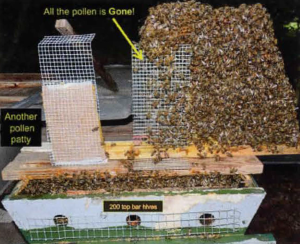
Figure 9 Feeding another pollen patty in late Summer. This power-house hive was in a three-foot hive and quickly consumed its first patty, which was in the empty hanger on the right. The next patty was the one on the left, propped up for the picture. With bees packing the hive full to the front end, I could certainly feed more than a third of a pound at a time.
Scientific investigation of honey bee nutrition has gained importance in recent years, leading to the development of pollen substitutes based on the bees’ physiological needs. Frame hive beekeepers have benefited from that research using commercially prepared pollen patties. Now top-bar hive beekeepers have a way to use them too, with little risk of the resource being taken over for small hive beetle reproduction.
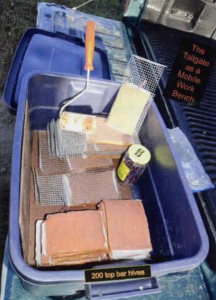
Figure 10 An efficient apiary work flow centered at the tailgate of the bee truck. Here is a storage container with loaded hangers and some extra patties cut into thirds. Returning from the hives, I drop the empty hangers into another container behind the cab of the bee truck.
Acknowledgments
The author thanks Suzanne Sumner for her comments on the manuscript.

